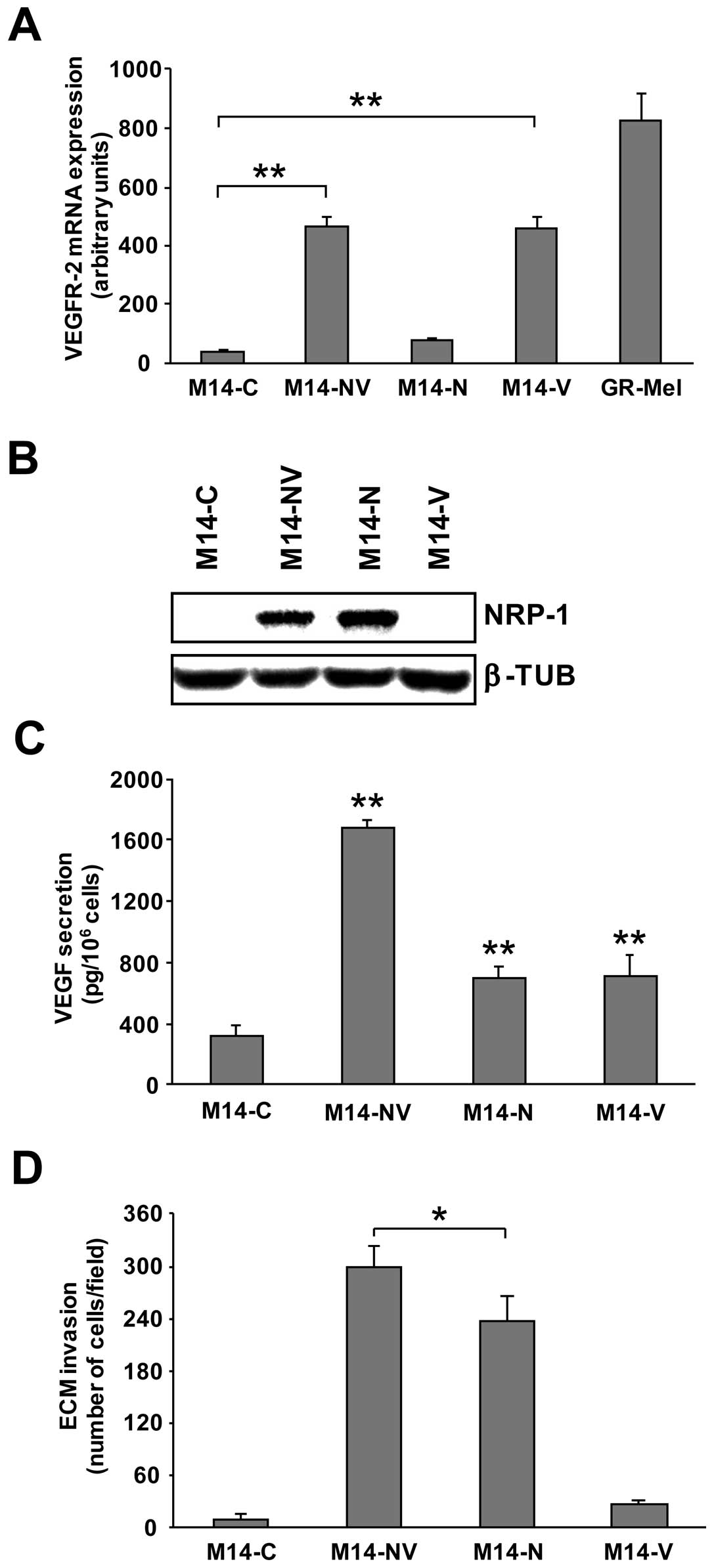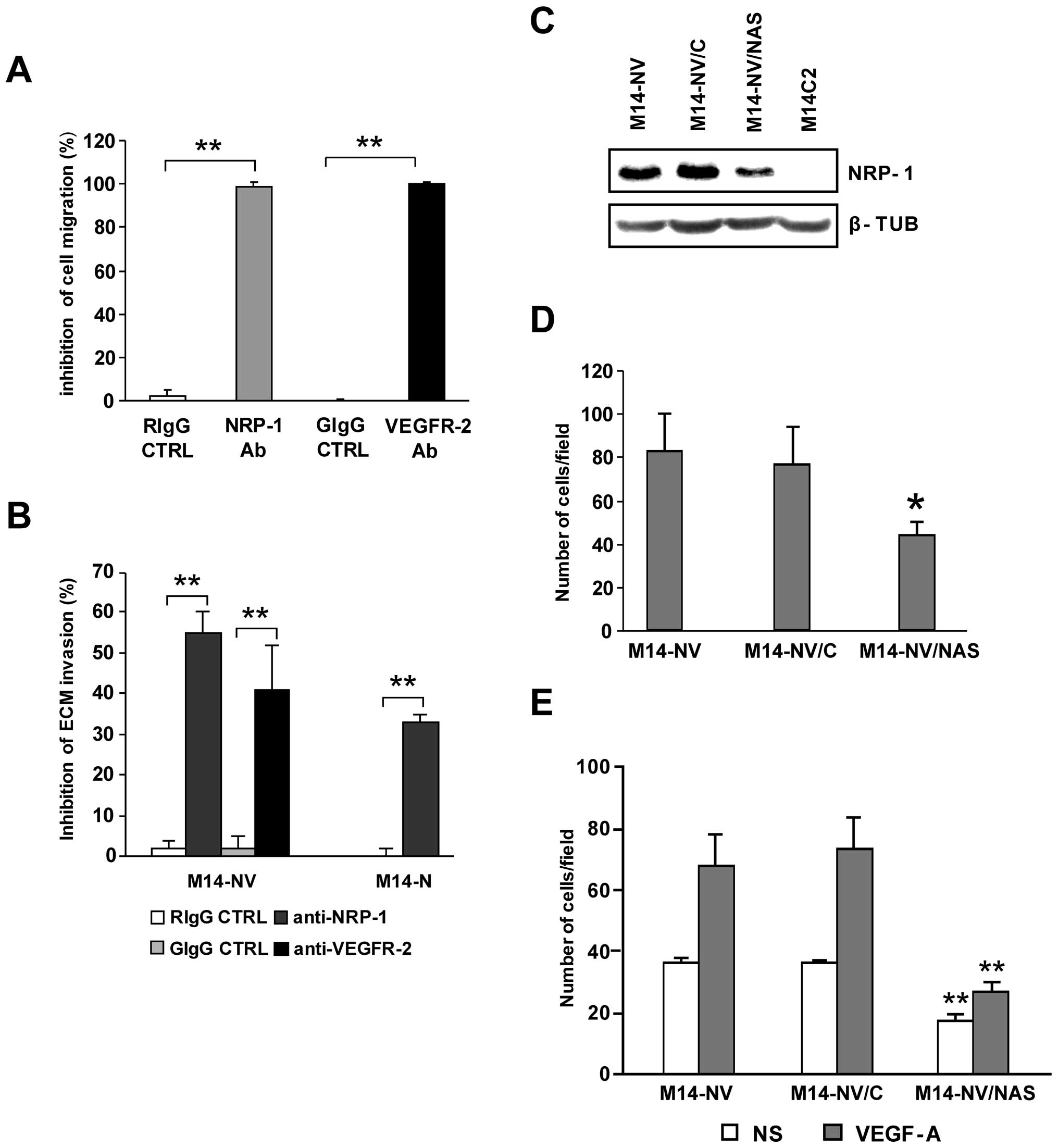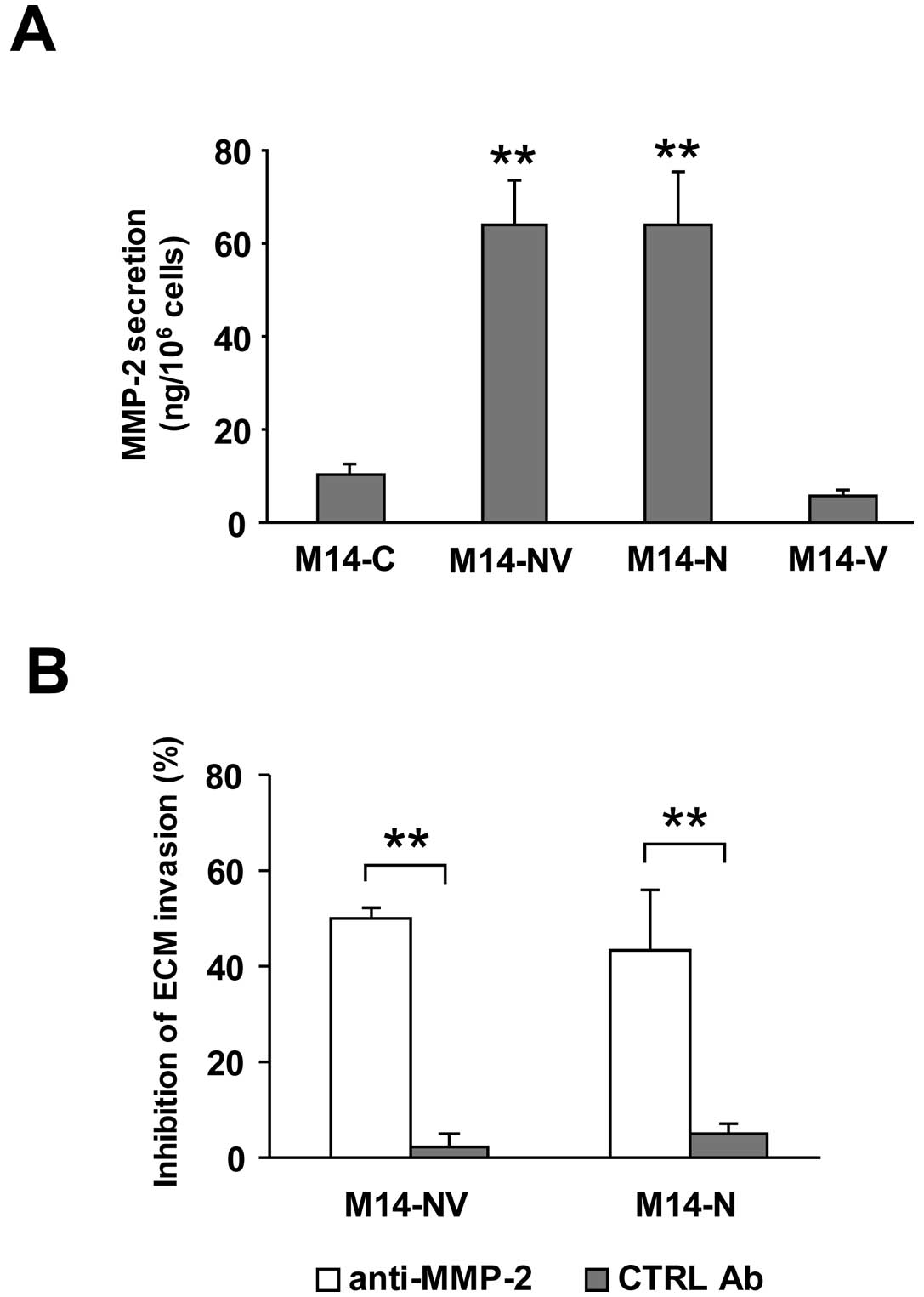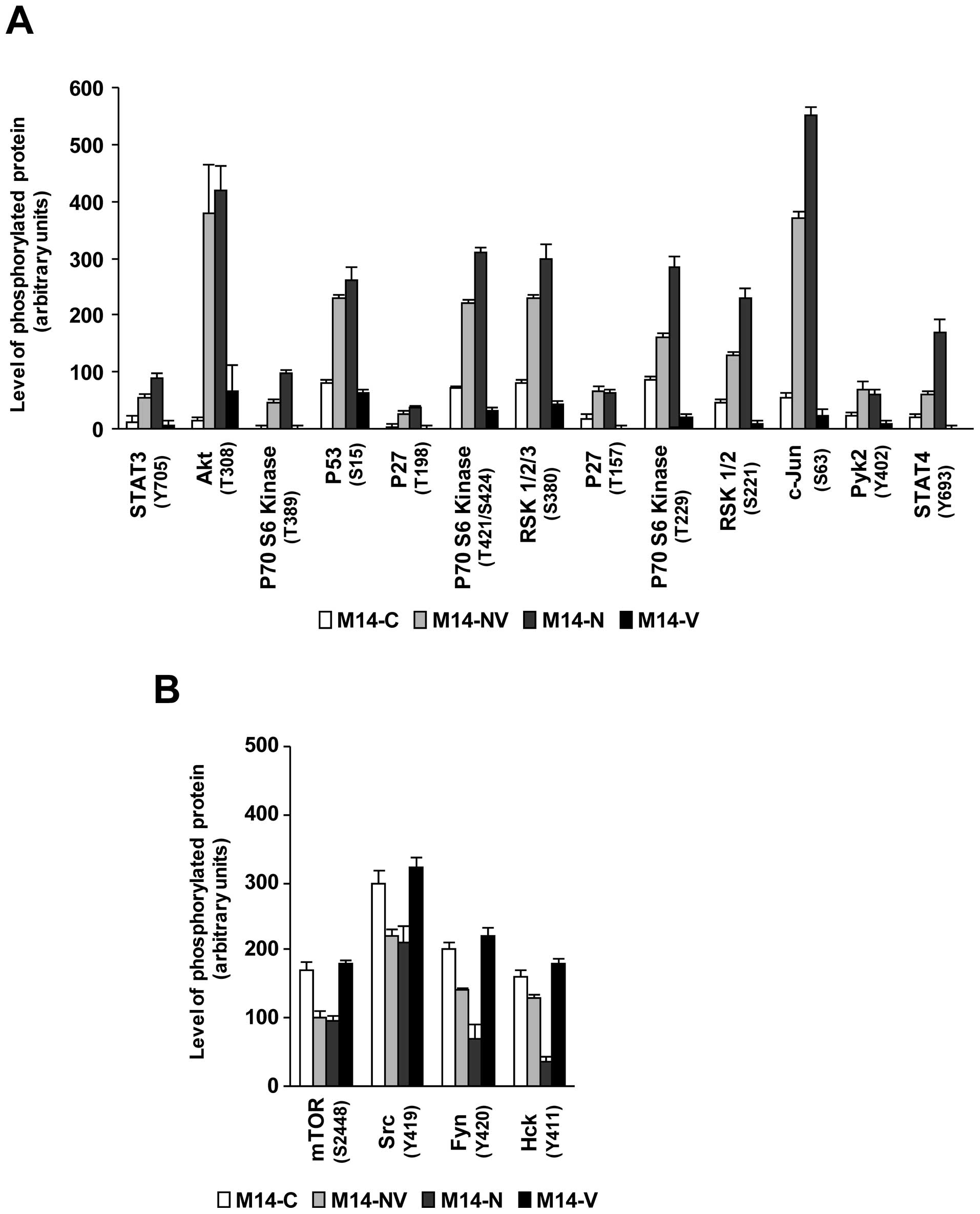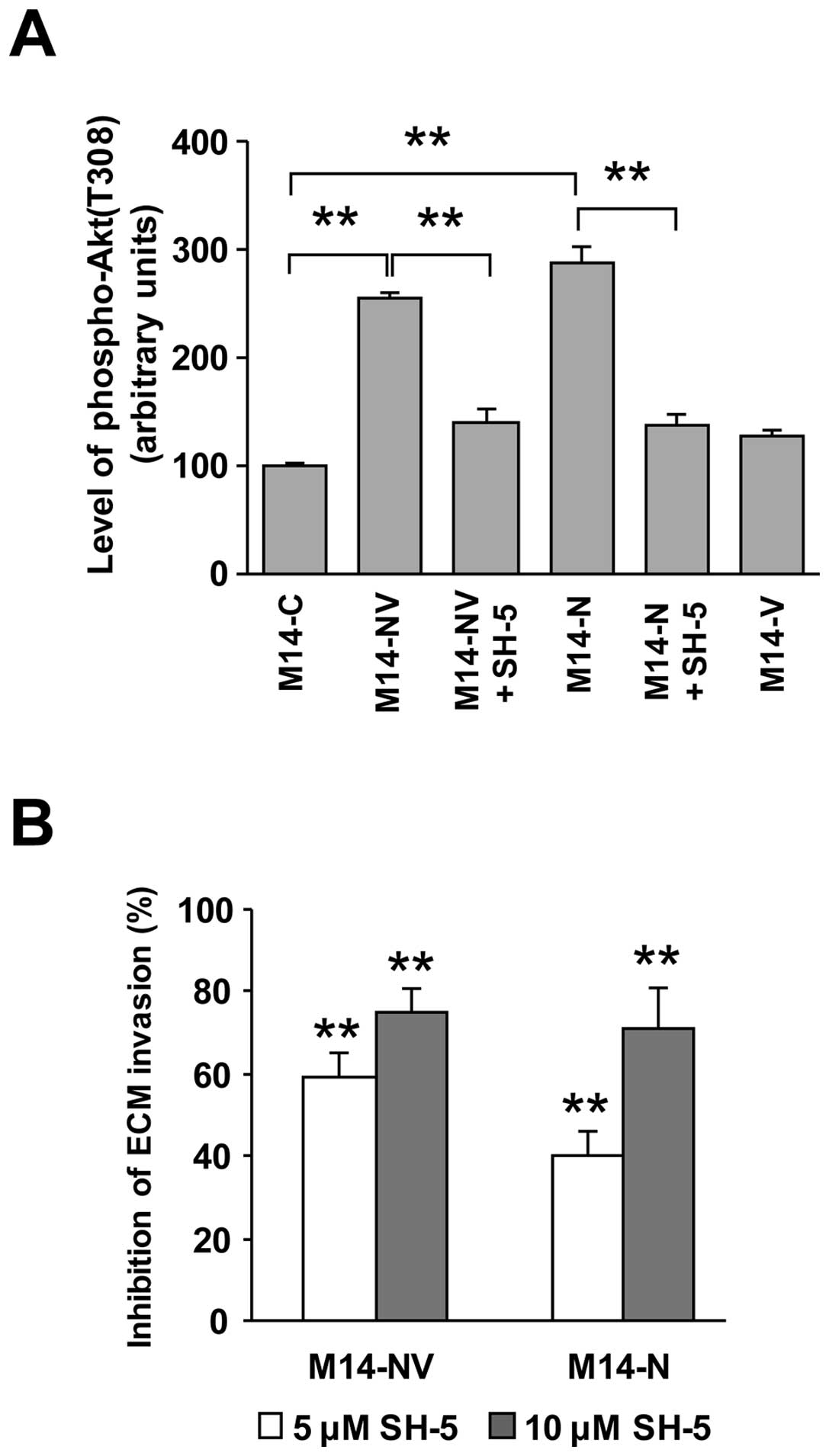|
1.
|
Danson S and Lorigan P: Improving outcomes
in advanced malignant melanoma: update on systemic therapy. Drugs.
65:733–743. 2005. View Article : Google Scholar : PubMed/NCBI
|
|
2.
|
Miller AJ and Mihm MC Jr: Melanoma. N Engl
J Med. 355:51–65. 2006. View Article : Google Scholar
|
|
3.
|
Marcoval J, Moreno A, Graells J, Vidal A,
Escriba JM, Garcia-Ramirez M and Fabra A: Angiogenesis and
malignant melanoma. Angiogenesis is related to the development of
vertical (tumorigenic) growth phase. J Cutan Pathol. 24:212–218.
1997. View Article : Google Scholar : PubMed/NCBI
|
|
4.
|
Herold-Mende C, Steiner H H, Andl T, et
al: Expression and functional significance of vascular endothelial
growth factor receptors in human tumor cells. Lab Invest.
79:1573–1582. 1999.PubMed/NCBI
|
|
5.
|
Pellet-Many C, Frankel P, Jia H and
Zachary I: Neuropilins: structure, function and role in disease.
Biochem J. 411:211–226. 2008. View Article : Google Scholar : PubMed/NCBI
|
|
6.
|
Geretti E, Shimizu A and Klagsbrun M:
Neuropilin structure governs VEGF and semaphorin binding and
regulates angiogenesis. Angiogenesis. 11:31–39. 2008. View Article : Google Scholar : PubMed/NCBI
|
|
7.
|
Grünewald FS, Prota AE, Giese A and
Ballmer-Hofer K: Structure-function analysis of VEGF receptor
activation and the role of coreceptors in angiogenic signaling.
Biochim Biophys Acta. 1804:567–580. 2010.PubMed/NCBI
|
|
8.
|
Bagri A, Tessier-Lavigne M and Watts RJ:
Neuropilins in tumor biology. Clin Cancer Res. 15:1860–1864. 2009.
View Article : Google Scholar
|
|
9.
|
Ellis LM: The role of neuropilins in
cancer. Mol Cancer Ther. 5:1099–1107. 2006. View Article : Google Scholar
|
|
10.
|
Latil A, Bieche I, Pesche S, Valeri A,
Fournier G, Cussenot O and Lidereau R: VEGF overexpression in
clinically localized prostate tumors and neuropilin-1
overexpression in metastatic forms. Int J Cancer. 89:167–171. 2000.
View Article : Google Scholar : PubMed/NCBI
|
|
11.
|
Hansel DE, Wilentz RE, Yeo CJ, Schulick
RD, Montgomery E and Maitra A: Expression of neuropilin-1 in
high-grade dysplasia, invasive cancer and metastases of the human
gastrointestinal tract. Am J Surg Pathol. 28:347–356. 2004.
View Article : Google Scholar : PubMed/NCBI
|
|
12.
|
Lacal PM, Failla CM, Pagani E, et al:
Human melanoma cells secrete and respond to placenta growth factor
and vascular endothelial growth factor. J Invest Dermatol.
115:1000–1007. 2000. View Article : Google Scholar : PubMed/NCBI
|
|
13.
|
Lacal PM, Ruffini F, Pagani E and D’Atri
S: An autocrine loop directed by the vascular endothelial growth
factor promotes invasiveness of human melanoma cells. Int J Oncol.
27:1625–1632. 2005.PubMed/NCBI
|
|
14.
|
Ruffini F, Failla CM, Orecchia A, et al:
Expression of the soluble vascular endothelial growth factor
receptor-1 in cutaneous melanoma: role in tumour progression. Br J
Dermatol. 164:1061–1070. 2011. View Article : Google Scholar : PubMed/NCBI
|
|
15.
|
Lacal PM, Morea V, Ruffini F, et al:
Inhibition of endothelial cell migration and angiogenesis by a
vascular endothelial growth factor receptor-1 derived peptide. Eur
J Cancer. 44:1914–1921. 2008. View Article : Google Scholar : PubMed/NCBI
|
|
16.
|
Chen H, He Z, Bagri A and Tessier-Lavigne
M: Semaphorinneuropilin interactions underlying sympathetic axon
responses to class III semaphorins. Neuron. 21:1283–1290. 1998.
View Article : Google Scholar : PubMed/NCBI
|
|
17.
|
Nakamura F, Tanaka M, Takahashi T, Kalb RG
and Strittmatter SM: Neuropilin-1 extracellular domains mediate
semaphorin D/III-induced growth cone collapse. Neuron.
21:1093–1100. 1998. View Article : Google Scholar : PubMed/NCBI
|
|
18.
|
Dai DL, Martinka M and Li G: Prognostic
significance of activated Akt expression in melanoma: a
clinicopathologic study of 292 cases. J Clin Oncol. 23:1473–1482.
2005. View Article : Google Scholar : PubMed/NCBI
|
|
19.
|
Robertson GP: Functional and therapeutic
significance of Akt deregulation in malignant melanoma. Cancer
Metastasis Rev. 24:273–285. 2005. View Article : Google Scholar : PubMed/NCBI
|
|
20.
|
Kozikowski AP, Sun H, Brognard J and
Dennis PA: Novel PI analogues selectively block activation of the
pro-survival serine/threonine kinase Akt. J Am Chem Soc.
125:1144–1145. 2003. View Article : Google Scholar : PubMed/NCBI
|
|
21.
|
Wang L, Zeng H, Wang P, Soker S and
Mukhopadhyay D: Neuropilin-1-mediated vascular permeability
factor/vascular endothelial growth factor-dependent endothelial
cell migration. J Biol Chem. 278:48848–48860. 2003. View Article : Google Scholar : PubMed/NCBI
|
|
22.
|
Murga M, Fernandez-Capetillo O and Tosato
G: Neuropilin-1 regulates attachment in human endothelial cells
independently of vascular endothelial growth factor receptor-2.
Blood. 105:1992–1999. 2005. View Article : Google Scholar : PubMed/NCBI
|
|
23.
|
Cai H and Reed RR: Cloning and
characterization of neuropilin-1-interacting protein: a
PSD-95/Dlg/ZO-1 domain-containing protein that interacts with the
cytoplasmic domain of neuropilin-1. J Neurosci. 19:6519–6527.
1999.PubMed/NCBI
|
|
24.
|
Chittenden TW, Claes F, Lanahan AA, et al:
Selective regulation of arterial branching morphogenesis by
synectin. Dev Cell. 10:783–795. 2006. View Article : Google Scholar : PubMed/NCBI
|
|
25.
|
Hofmann UB, Westphal JR, Zendman AJ,
Becker JC, Ruiter DJ and van Muijen GNP: Expression and activation
of matrix metal-loproteinase-2 (MMP-2) and its co-localization with
membrane type matrix metalloproteinase 1 (MT1-MMP) correlate with
melanoma progression. J Pathol. 191:245–256. 2000. View Article : Google Scholar : PubMed/NCBI
|
|
26.
|
Väisänen A, Kallioinen M, Taskinen PJ and
Turpeenniemi-Hujanen T: Prognostic value of MMP-2 immunoreactive
protein (72 kD type IV collagenase) in primary skin melanoma. J
Pathol. 186:51–58. 1998.PubMed/NCBI
|
|
27.
|
Fukasawa M, Matsushita A and Korc M:
Neuropilin-1 interacts with integrin beta1 and modulates pancreatic
cancer cell growth, survival and invasion. Cancer Biol Ther.
6:1173–1180. 2007. View Article : Google Scholar : PubMed/NCBI
|
|
28.
|
Westermarck J and Kähäri VM: Regulation of
matrix metalloproteinase expression in tumor invasion. FASEB J.
13:781–792. 1999.PubMed/NCBI
|
|
29.
|
Park BK, Zeng X and Glazer RI: Akt1
induces extracellular matrix invasion and matrix
metalloproteinase-2 activity in mouse mammary epithelial cells.
Cancer Res. 61:7647–7653. 2001.PubMed/NCBI
|
|
30.
|
Tremblay F, Brule S, Hee Um S, et al:
Identification of IRS-1 Ser-1101 as a target of S6K1 in nutrient
and obesity-induced insulin resistance. Proc Natl Acad Sci USA.
104:14056–14061. 2007. View Article : Google Scholar : PubMed/NCBI
|
|
31.
|
Kong M, Fox CJ, Mu J, et al: The
PP2A-associated protein alpha4 is an essential inhibitor of
apoptosis. Science. 306:695–698. 2004. View Article : Google Scholar : PubMed/NCBI
|
|
32.
|
Kuo YC, Huang KY, Yang CH, Yang YS, Lee WY
and Chiang CW: Regulation of phosphorylation of Thr-308 of Akt,
cell proliferation and survival by the B55alpha regulatory subunit
targeting of the protein phosphatase 2A holoenzyme to Akt. J Biol
Chem. 283:1882–1892. 2008. View Article : Google Scholar : PubMed/NCBI
|
|
33.
|
Steelman LS, Stadelman KM, Chappell WH, et
al: Akt as a therapeutic target in cancer. Expert Opin Ther
Targets. 12:1139–1165. 2008. View Article : Google Scholar : PubMed/NCBI
|
|
34.
|
Guo D, Hildebrandt IJ, Prins RM, et al:
The AMPK agonist AICAR inhibits the growth of EGFRvIII-expressing
glioblastomas by inhibiting lipogenesis. Proc Natl Acad Sci USA.
106:12932–12937. 2009. View Article : Google Scholar : PubMed/NCBI
|
|
35.
|
Rodrik-Outmezguine V, Chandarlapaty S,
Pagano N, et al: mTOR kinase inhibition causes feedback-dependent
biphasic regulation of AKT signalling. Cancer Discov. 3:248–259.
2011. View Article : Google Scholar : PubMed/NCBI
|
|
36.
|
Fenton TR and Gout IT: Functions and
regulation of the 70 kDa ribosomal S6 kinases. Int J Biochem Cell
Biol. 43:47–59. 2011. View Article : Google Scholar : PubMed/NCBI
|
|
37.
|
Romeo Y, Zhang X and Roux PP: Regulation
and function of the RSK family of protein kinases. Biochem J.
441:553–569. 2012. View Article : Google Scholar : PubMed/NCBI
|
|
38.
|
Doehn U, Hauge C, Frank SR, et al: RSK is
a principal effector of the RAS–ERK pathway for eliciting a
coordinate promotile/invasive gene program and phenotype in
epithelial cells. Mol Cell. 35:511–522. 2009.
|
|
39.
|
Smolen GA, Zhang J, Zubrowski MJ, et al: A
genome-wide RNAi screen identifies multiple RSK-dependent
regulators of cell migration. Genes Dev. 24:2654–2665. 2010.
View Article : Google Scholar : PubMed/NCBI
|
|
40.
|
Tanimura S, Hashizume J, Kurosaki Y, et
al: SH3P2 is a negative regulator of cell motility whose function
is inhibited by ribosomal S6 kinase-mediated phosphorylation. Genes
Cells. 16:514–526. 2011. View Article : Google Scholar : PubMed/NCBI
|
|
41.
|
Mora A, Komander D, Van Aalten DM and
Alessi DR: PDK1, the master regulator of AGC kinase signal
transduction. Semin Cell Dev Biol. 15:161–170. 2004. View Article : Google Scholar : PubMed/NCBI
|



